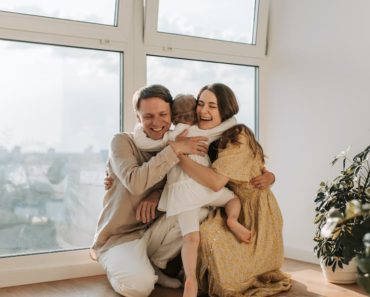Contents
- 1 Building a Strong Therapeutic Relationship in the Stepparent Context
- 2 Understanding the Therapeutic Relationship in Stepparenting
- 2.1 How can a stepparent establish a healthy therapeutic relationship with their stepchild, considering the unique dynamics and challenges of blended families?
- 2.2 What strategies or interventions can a stepparent use to build trust and rapport with their stepchild, fostering a positive therapeutic relationship?
- 2.3 How can a stepparent navigate the complexities of co-parenting and collaborate with the biological parent to create a supportive therapeutic environment for the child? Please note that these questions can serve as a starting point for exploring the topic of therapeutic relationship in the context of stepparenting. They can be further customized or expanded upon based on specific interests or research goals.
- 2.4 Related Posts

Welcome to Stepparent Magazine! In this article, we explore the importance of building a therapeutic relationship as a stepparent. Discover how nurturing this bond can create a strong foundation for a harmonious blended family. Join us on this journey as we delve into effective strategies and techniques for cultivating a healthy and supportive environment.
Building a Strong Therapeutic Relationship in the Stepparent Context
Building a strong therapeutic relationship in the stepparent context is crucial for the well-being of all family members involved. Stepparents often face unique challenges as they navigate their role within blended families. Establishing trust and open communication are key elements in fostering a healthy stepparent-stepchild relationship.
One important aspect to consider in building this relationship is acknowledging the complexity of the stepparent’s position. Unlike biological parents, stepparents come into a child’s life at a later stage, which can create a sense of ambiguity and unease. Recognizing and addressing these feelings with empathy and understanding can help lay a solid foundation for a strong bond.
Another crucial element in developing a strong therapeutic relationship is active listening. Stepparents should strive to listen attentively to their stepchild’s concerns, thoughts, and feelings without judgment or criticism. This not only helps build trust but also demonstrates that their viewpoints are valued and respected.
Furthermore, it is important for stepparents to establish clear boundaries within the family dynamic. By setting expectations and routines together with the biological parent, a stepparent can provide a sense of security and consistency for the child. Clear and consistent rules can help minimize potential conflicts and promote a harmonious home environment.
Lastly, empathy and patience are essential qualities for stepparents to possess. Each member of the blended family may have experienced loss or separation, and everyone’s adjustment process may differ. By demonstrating understanding and patience, stepparents can support their stepchild’s emotional journey and foster a stronger therapeutic relationship.
In conclusion, building a strong therapeutic relationship in the stepparent context requires establishing trust, open communication, active listening, clear boundaries, and empathy. By prioritizing these elements, stepparents can contribute to a positive and nurturing environment for their stepchildren and promote the overall well-being of the blended family.
Understanding the Therapeutic Relationship in Stepparenting
1. Building Trust and Connection
In the realm of stepparenting, the therapeutic relationship plays a crucial role in establishing trust and connection between the stepparent and stepchild. This relationship is built upon empathy and understanding, where the stepparent creates a safe and supportive environment for the stepchild to express their feelings and concerns. Through active listening and open communication, the stepparent demonstrates their willingness to be present and emotionally available, fostering a sense of trust and connection.
2. Navigating Complex Dynamics and Roles
Stepparenting involves navigating complex dynamics and roles within the blended family. The therapeutic relationship helps the stepparent understand the unique challenges and emotions that arise in these dynamics. By acknowledging and validating the stepchild’s experiences and perspectives, the stepparent can foster a sense of belonging and reduce potential conflicts. This relationship provides a space for open dialogue, where both the stepparent and stepchild can explore their roles and expectations within the family system.
3. Supporting Emotional Growth and Well-being
The therapeutic relationship in stepparenting acts as a support system for the stepchild’s emotional growth and well-being. The stepparent creates a nurturing environment where the stepchild feels safe to express their emotions, knowing that they will be heard and understood. By offering guidance, validation, and empathy, the stepparent helps the stepchild develop healthy coping mechanisms and build resilience. This relationship also benefits the stepparent, as it allows them to navigate their own emotions and challenges in a supportive and therapeutic manner.
How can a stepparent establish a healthy therapeutic relationship with their stepchild, considering the unique dynamics and challenges of blended families?
Establishing a healthy therapeutic relationship with a stepchild in the context of blended families can be challenging, but it is crucial for the well-being of everyone involved. Here are some tips to help stepparents navigate this unique situation:
1. Respect the child’s emotions and boundaries: Recognize that it may take time for the stepchild to warm up to you. Respect their feelings and allow them to set their own boundaries. Avoid pressuring them to accept you quickly.
2. Develop trust: Trust is the foundation of any relationship. Be consistent, reliable, and keep your promises. Show the stepchild that you care about their well-being by being supportive and understanding.
3. Communicate openly: Encourage open and honest communication with the stepchild. Create a safe space where they feel comfortable expressing their thoughts and concerns without fear of judgment. Listen actively and validate their feelings.
4. Build shared experiences: Engage in activities that the stepchild enjoys and create opportunities to bond. Take interest in their hobbies, attend their school events, or plan family outings together. These shared experiences can help foster a sense of belonging.
5. Work as a team with the biological parent: Consistent communication and collaboration with the biological parent are essential. Establish clear expectations, boundaries, and parenting strategies. Present a united front to demonstrate a unified approach to parenting.
6. Seek professional help if needed: If the challenges are overwhelming or conflicts arise, consider seeking the assistance of a family therapist or counselor who specializes in blended families. They can provide guidance and support for the whole family.
Remember, building a healthy therapeutic relationship with a stepchild takes time, patience, and effort. Each child is unique, so it’s important to tailor your approach to their specific needs and personality.
What strategies or interventions can a stepparent use to build trust and rapport with their stepchild, fostering a positive therapeutic relationship?
Building trust and rapport with a stepchild as a stepparent can be a complex process, but there are several strategies and interventions that can help foster a positive therapeutic relationship.
1. Patience and Understanding: Recognize that building trust takes time, especially in a blended family situation. Be patient and understanding with your stepchild’s emotions and reactions, acknowledging that they may feel confused or hesitant.
2. Respect Boundaries: When entering a stepchild’s life, it is important to respect their boundaries. Allow them to set the pace for developing a relationship and avoid pushing them to open up before they are ready.
3. Active Listening: Practice active listening skills by giving your stepchild your undivided attention when they talk. Show genuine interest in their thoughts, feelings, and experiences, making them feel valued and heard.
4. Positive Reinforcement: Acknowledge and praise your stepchild’s efforts, achievements, and positive behaviors. This helps build their self-esteem and creates a positive environment for relationship development.
5. Establish Clear Expectations: Create clear and consistent expectations and rules within the family. Involve your stepchild in the process, allowing them to have a voice and providing structure and stability.
6. Quality Time: Spend quality one-on-one time with your stepchild, engaging in activities they enjoy. This will help build shared experiences and strengthen your bond.
7. Communication: Maintain open lines of communication with your stepchild. Encourage them to express their thoughts and feelings, and validate their emotions even if you may not agree with them.
8. Seek Professional Help: If the dynamics are particularly challenging or if there are unresolved emotional issues, seeking professional help through family therapy or counseling can provide guidance and support.
Remember, every stepchild is unique, and the building of trust and rapport may vary from one individual to another. Consistency, patience, and empathy are key components for fostering a positive therapeutic relationship as a stepparent.
Navigating the complexities of co-parenting as a stepparent and collaborating with the biological parent to create a supportive therapeutic environment for the child can be challenging but crucial. Here are some tips on how to approach this:
1. Build open communication: Establishing healthy communication channels with the biological parent is essential. Regularly discuss the child’s needs, concerns, and any changes in their behavior or emotional well-being. This can help both parents understand and address potential therapeutic needs.
2. Respect boundaries and roles: Recognize and respect the different roles each parent plays in the child’s life. Understand that as a stepparent, you may have a supportive role, but the biological parent generally holds primary decision-making authority. Collaborate with the biological parent to find the right balance between involvement and respecting boundaries within the therapeutic process.
3. Educate yourself: Take the initiative to educate yourself about the child’s specific therapeutic needs. Attend therapy sessions, read relevant literature, and engage in conversations with professionals to gain a better understanding of how to support the child’s well-being.
4. Be proactive in seeking professional help: If the child requires therapeutic intervention, advocate for their needs together with the biological parent. Seek out therapists or counselors experienced in working with blended families. Involve both parents in the therapeutic process to ensure a holistic and collaborative approach.
5. Maintain consistency and routines: Creating a supportive therapeutic environment involves establishing consistent routines and rules between households. This helps provide stability for the child and minimizes confusion or conflict between the different parenting units. Collaborate with the biological parent to align strategies and expectations to create a seamless transition for the child.
6. Foster positive relationships: Encourage positive interactions between the child, the biological parent, and yourself. Model healthy communication, empathy, and respect in your relationship with the biological parent, which can positively impact the child’s perception of the therapeutic environment. Engage in joint activities whenever possible to promote bonding and a sense of unity.
7. Seek professional mediation if needed: In situations where conflicts or disagreements arise between the stepparent and biological parent, consider involving a neutral third party, such as a mediator or family therapist. They can help facilitate productive discussions and improve co-parenting dynamics.
Remember, being a stepparent in a therapeutic context requires patience, flexibility, and a deep commitment to the child’s well-being. Strong collaboration with the biological parent is key in creating a supportive environment that fosters the child’s emotional growth and healing.
In conclusion, establishing a therapeutic relationship is vital in the context of Stepparenting. Through open communication, empathy, and understanding, stepparents can create a safe and supportive environment for their stepchildren. Building trust and rapport takes time and effort, but the rewards are immeasurable. By actively engaging in this therapeutic relationship, stepparents can foster growth, healing, and resilience within their blended families. With patience and dedication, they can strive towards creating harmonious and loving relationships that transcend traditional family boundaries.







